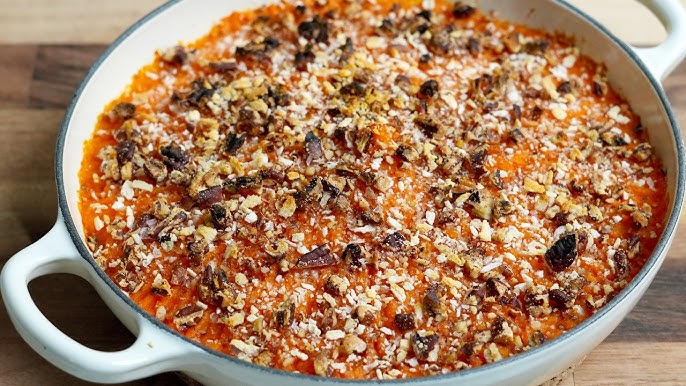Sweet Potato Mash Recipe: There’s something magical about a bowl of perfectly mashed sweet potatoes. It’s comforting, cozy, and brings back memories of family dinners, holidays, and cozy evenings. Unlike regular mashed potatoes, sweet potato mash is naturally sweet and packed with flavor—and when done right, it’s creamy, velvety, and utterly satisfying.
Not only does sweet potato mash taste amazing, but it’s also a nutrition powerhouse. Sweet potatoes are loaded with beta-carotene (which the body converts into vitamin A), dietary fiber, potassium, and antioxidants. Whether you’re trying to eat healthier or simply looking to add a little color and flair to your dinner table, sweet potato mash is the perfect side dish.
This guide walks you through everything—from picking the right sweet potatoes to mashing them up into the creamiest, dreamiest dish you’ve ever made. Ready to dive in?
Ingredients You’ll Need
Before we dive into the cooking process, let’s start with the basics: ingredients. Sweet potato mash is incredibly simple and requires just a handful of pantry staples. Here’s what you need for the classic version:
Essential Ingredients:
- 4 large sweet potatoes
- 4 tablespoons unsalted butter (more if you like it richer)
- ½ cup heavy cream or milk (use plant-based milk for dairy-free)
- Salt to taste
- Pepper to taste
Optional Add-ins & Flavor Variations:
- 2 tablespoons brown sugar or maple syrup (for a touch of sweetness)
- A pinch of cinnamon or nutmeg (adds warmth)
- Roasted garlic (for a savory twist)
- Chopped fresh herbs like rosemary, thyme, or parsley
- Sour cream or cream cheese for extra creaminess
You can play with the flavors depending on your mood or the occasion. Want something sweet and decadent for Thanksgiving? Add marshmallows or a pecan topping. Craving something spicy? A touch of cayenne or chipotle powder works wonders.
How to Choose the Best Sweet Potatoes
Not all sweet potatoes are created equal. If you want that perfect mash consistency—smooth, creamy, and lump-free—you’ll want to start with the best produce. Here’s how to spot winners at the store:
What to Look For:
- Firmness: Choose sweet potatoes that feel firm and heavy for their size.
- Skin: The skin should be smooth and free from cuts, bruises, or sprouting eyes.
- Size: Medium to large sweet potatoes are ideal. They’re easier to peel and chop evenly.
Avoid sweet potatoes that are wrinkled, have soft spots, or show signs of decay. These are past their prime and won’t give you the rich texture you’re aiming for.
Storage Tips:
Once you bring them home, keep sweet potatoes in a cool, dark, and well-ventilated place—like a pantry. Avoid the fridge, as it can alter their flavor and make them hard in texture. Stored properly, they can last up to two weeks or even longer.
Step-by-Step Instructions to Make Sweet Potato Mash
This is where the magic happens. Follow these steps carefully, and you’ll have a batch of mash that’s silky smooth and bursting with flavor.
Step 1: Wash and Peel the Sweet Potatoes
Always start by giving your sweet potatoes a good rinse under cold water. Even if you’re going to peel them, it’s essential to remove any dirt or debris. Use a vegetable brush if needed.
Peel the sweet potatoes with a standard vegetable peeler. Their skin is a bit tougher than regular potatoes, so take your time. Make sure to remove any rough or stringy bits as well.
Step 2: Chop into Even-Sized Chunks
Uniformity is key here. Cut your peeled sweet potatoes into 1-2 inch chunks. This helps them cook evenly and ensures that all the pieces are tender at the same time. If your chunks are too big, they might be undercooked inside, and nobody wants lumpy mash!
Also, chopping smaller speeds up the boiling time—less waiting, more eating.
Step 3: Boil Until Tender
Place the chunks into a large pot and fill with enough cold water to cover them by an inch or two. Add a generous pinch of salt—just like you would with pasta. This helps season the potatoes from the inside out.
Bring the pot to a boil, then reduce to a simmer. Let the sweet potatoes cook for about 15–20 minutes or until fork-tender. You should be able to easily pierce a chunk with a fork without resistance.
Step 4: Drain and Let Steam Dry
Once cooked, drain the sweet potatoes in a colander. But don’t mash them just yet—let them sit in the colander for 5 minutes. This allows excess moisture to evaporate, resulting in a thicker, richer mash. If they’re too watery, you’ll end up with a soupy mess.
Letting them steam dry makes all the difference in texture.
Step 5: Mash to Desired Texture
Now comes the fun part—mashing! Depending on the kind of texture you like, you can go super smooth or leave a few chunks for a more rustic feel. There are a few tools you can use here:
- Hand masher: The classic choice. It gives you control and a little workout.
- Electric hand mixer: Great for a creamier, whipped texture.
- Food processor: This gives an ultra-smooth puree but can sometimes make the mash gluey if overprocessed.
Start mashing the cooked, dry sweet potato chunks while they’re still hot. This makes it easier to break them down and incorporate the butter and cream evenly. If you’re using a masher, go slowly and work through all the chunks until you reach the consistency you like. If you’re aiming for ultra-smooth, switch to a mixer or food processor after mashing lightly.
Step 6: Add Butter, Cream, and Seasonings
Once the texture is just right, it’s time to bring in the flavor. Add your butter first—make sure it’s at room temperature or slightly melted so it blends easily. Stir until fully incorporated and watch as the mash turns rich and glossy.
Next, slowly pour in the cream or milk while continuing to mix. Add just a little at a time until you hit your desired level of creaminess. Be sure not to add too much all at once—you can always pour more, but you can’t take it out once it’s in!
Season with salt and pepper to taste. This is also the perfect time to toss in any add-ons like brown sugar, maple syrup, cinnamon, or roasted garlic. Fold everything in gently to keep the mash light and fluffy.
Step 7: Mix Thoroughly and Taste Test
Before serving, give your mash one final mix and—most importantly—a taste test. This is your last chance to adjust the flavors. Need a little more salt? A splash more cream? Maybe a pinch of nutmeg or a dollop of sour cream for extra tang?
Don’t rush this part. A good mash is all about balance. Take a spoonful, close your eyes, and savor the texture and flavor. If you’re satisfied, then you’re ready to serve!
Tips for the Creamiest Sweet Potato Mash
If you’re aiming for restaurant-quality smoothness, here are some pro tips to keep in your back pocket.
1. Don’t Overcook or Undercook
Overcooked sweet potatoes become waterlogged, while undercooked ones make your mash grainy and lumpy. Aim for just-tender. Check them at the 15-minute mark while boiling.
2. Let Them Steam Dry
As mentioned earlier, steam drying makes a massive difference. Even a few minutes of rest in the colander helps get rid of excess moisture that can make your mash runny.
3. Use Room Temperature Ingredients
Cold butter or cream can shock your sweet potatoes, leading to clumps. Always let your ingredients sit out for a bit before mixing.
4. Don’t Over-Mix
It might be tempting to beat the mash until it’s ultra-smooth, but over-mixing can cause the starches to become gluey. Mix just enough to combine everything.
5. Try a Ricer or Food Mill
If you want that ultra-luxurious finish, a potato ricer or food mill breaks down sweet potatoes into a super-fine texture without making them sticky.
Flavor Variations You Can Try
One of the best parts about sweet potato mash is how versatile it is. With just a few tweaks, you can completely change its personality. Here are some fun variations to experiment with:
Savory Garlic Herb Mash
- Add roasted garlic cloves while mashing
- Mix in fresh chopped rosemary or thyme
- Finish with a drizzle of olive oil instead of butter
This version pairs beautifully with roast chicken or grilled steak.
Maple Pecan Mash
- Stir in 2 tablespoons of maple syrup
- Top with toasted chopped pecans
- Add a sprinkle of cinnamon or nutmeg
A sweet and festive version perfect for holiday dinners.
Spicy Chipotle Mash
- Mix in chipotle powder or adobo sauce
- Add a splash of lime juice
- Garnish with chopped cilantro
This one’s bold, smoky, and perfect as a side with BBQ or tacos.
Get creative and make it your own. Sweet potatoes are the ultimate canvas for flavor experiments.
Serving Suggestions
Wondering what goes well with sweet potato mash? Here are some classic and creative pairings:
Traditional Pairings:
- Roast turkey or chicken
- Glazed ham
- Meatloaf
- Gravy (yes, even on sweet potatoes!)
Healthy Combos:
- Grilled salmon or shrimp
- Steamed broccoli or green beans
- Chickpea stew or lentil curry
Fun and Unusual Ideas:
- Use it as a topping for shepherd’s pie
- Add to wraps or burritos for sweetness and creaminess
- Serve in a bowl with black beans, avocado, and salsa
Sweet potato mash doesn’t have to be a side dish—make it the star if you want!
Storage and Reheating Tips
One of the great things about sweet potato mash is how well it stores. If you’ve made a big batch (and honestly, why wouldn’t you?), here’s how to keep it tasting fresh for days—or even weeks.
Refrigerator Storage:
- Transfer the mash into an airtight container as soon as it cools.
- It will stay fresh in the fridge for up to 4–5 days.
- To prevent it from drying out, press a piece of plastic wrap directly onto the surface before sealing the lid.
Freezer Storage:
Yes, you can freeze sweet potato mash! It’s a game-changer for meal prep.
- Spoon the mash into freezer-safe bags or containers.
- Press out as much air as possible to prevent freezer burn.
- Label with the date—it’s best used within 2–3 months.
- Flatten bags to save space and make thawing quicker.
Reheating Tips:
- Microwave: Place in a microwave-safe bowl, cover loosely, and heat in 1-minute intervals, stirring in between. Add a splash of milk or butter to restore creaminess.
- Stovetop: Warm gently in a saucepan over low heat, stirring often. Add liquid if needed to loosen it up.
- Oven: If reheating a large batch, cover with foil and warm in a 325°F (165°C) oven for 20–30 minutes.
Never reheat more than once to preserve flavor and texture.
Common Mistakes to Avoid
Even a simple dish like sweet potato mash has its share of pitfalls. Here are the top mistakes people make—and how you can avoid them:
1. Skipping the Salt
Sweet potatoes are naturally sweet, so a little salt goes a long way to balance the flavors. Don’t skip it! Even if you’re going sweet with maple syrup, a pinch of salt enhances the taste.
2. Overcooking the Potatoes
Boiling too long causes them to absorb excess water, resulting in a runny mash. Test frequently and drain as soon as they’re fork-tender.
3. Not Draining Properly
Draining and letting them steam dry is key to thick, fluffy mash. If they’re wet, the butter and cream won’t blend well.
4. Over-mixing
Once you’ve added the butter and cream, mix just until combined. Overdoing it breaks down the starches, making the mash gluey.
5. Using Cold Ingredients
Always use room temperature or slightly warm butter and cream. Cold ingredients shock the hot sweet potatoes, leading to clumps.
6. Ignoring Texture Preferences
Some like it chunky, some like it smooth. Decide what you want beforehand so you know how much to mash or blend.
Learn from these common errors and you’ll always end up with a bowl of delicious, smooth sweet potato mash that everyone will rave about.
Health Benefits of Sweet Potatoes
Beyond their comforting flavor, sweet potatoes are a nutritional goldmine. Here’s why you should feel good about diving into a bowl of mash:
1. Rich in Beta-Carotene
Sweet potatoes are high in beta-carotene, a powerful antioxidant that your body converts into vitamin A. This nutrient is essential for vision, immune health, and skin.
2. High in Fiber
A bowl of sweet potato mash helps with digestion and promotes a healthy gut. Fiber also helps keep you full longer, making it great for managing hunger and weight.
3. Packed with Vitamins & Minerals
They’re a good source of vitamin C, manganese, potassium, and vitamin B6. Each of these supports key body functions, from reducing inflammation to supporting brain health.
4. Supports Blood Sugar Balance
Despite being naturally sweet, sweet potatoes have a relatively low glycemic index—meaning they won’t cause wild spikes in blood sugar like other carbs might.
5. Good for All Diets
Whether you’re vegetarian, vegan, gluten-free, or paleo, sweet potatoes fit seamlessly into almost every eating plan. Just adjust the add-ins to suit your needs.
So yes, this side dish isn’t just tasty—it’s a healthy choice, too.
FAQs about Sweet Potato Mash Recipe
1. Can I make sweet potato mash ahead of time?
Yes! You can prepare it up to 3 days in advance. Store it in an airtight container in the fridge and reheat gently with a splash of cream or milk before serving.
2. How do I make it dairy-free?
Replace butter with vegan butter or olive oil, and use coconut milk, almond milk, or oat milk instead of cream. The flavor will still be rich and satisfying.
3. What’s the best way to sweeten sweet potato mash naturally?
Maple syrup, honey, or mashed ripe bananas are great natural sweeteners. A sprinkle of cinnamon or nutmeg enhances the sweetness, too.
4. Can I freeze sweet potato mash?
Absolutely. Cool it completely, then freeze in airtight containers or bags. Thaw in the fridge and reheat on the stove or microwave with a bit of added liquid.
5. Is sweet potato mash healthy for kids?
Yes! It’s packed with fiber, vitamins, and antioxidants, and kids love the naturally sweet taste. You can make it even more nutritious by sneaking in pureed carrots or squash.
Conclusion
Sweet potato mash is one of those timeless comfort foods that never goes out of style. Whether you keep it simple with butter and cream or jazz it up with garlic, herbs, or maple syrup, this dish always delivers. It’s easy to make, healthy, versatile, and deeply satisfying. Plus, it’s a breeze to prep ahead and store.
Next time you’re thinking of a cozy side for dinner or a star for your holiday spread, turn to sweet potato mash. Follow this step-by-step guide, avoid the common mistakes, and experiment with flavors—you’ll be a mash master in no time.



